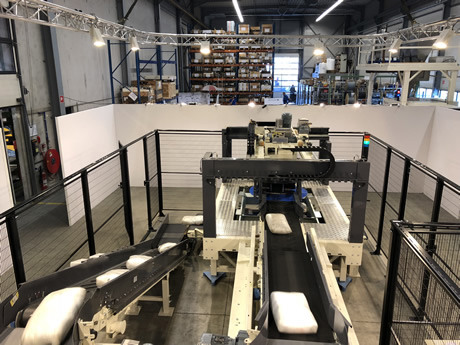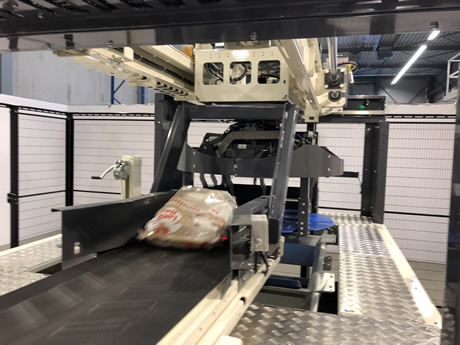Promotion, recruitment and the presentation of a new concept palletising machine were central during the open days of Symach in Terneuzen, the Netherlands.

Please click here for the photo report.
The patented prototype of a new generation of palletising machines were shown by Symach. Why continue developing a machine that’s already proven itself in the fresh produce sector, and outside of that sector as well? The arrival of MSP’s new onion factory resulted in demand for more capacity. In the production line, the palletising machine caused a bottleneck so that higher production couldn’t be achieved. The current generation of palletising machines can place about 36 bags per minute on a pallet.
To invent something new, Symach’s Research & Development department returned to the basics of the current palletising process. An important part of the current Symach machines is the filling tray that treats each bag individually. The principle of this is that the bags in the filling tray slide across a smooth floor and against a fixed end partition, and they are then centred completely in the middle. Because of this, the position of the bag in the filling tray is ‘fixed,’ and the bag is then released exactly above the programmed spot.
Please click here for the photo report.
The disadvantage of this system is that there’s only one opening and the filling tray has to turn 180 degrees to get the filling opening pointed towards the supply belt. A new bag will already be waiting on the supply belt, because the filling tray has to turn back to its receiving position after unloading. A lot of time is lost this way. The solution for realising a higher capacity had to be found in a smarter and more efficient use of the rotating filling tray, and not in higher speeds of the current filling tray.
To achieve this, a head had to be developed, which could receive a bag from four sides without first having to turn back to its loading position. The fixed end partition from the current head had to be changed into a moveable end partition with a combined function: end partition and centring unit. Various ideas were suggested and tested during the process. In the end, a system that can open in two different corners was chosen. This resulted in the development of a filling tray that consists of four quarters of a circle. Each quarter can separately turn two ways, so that inefficient movements are no longer necessary.

The capacity compared to the previous generation of palletising machines has increased by about 27 per cent, from 36 bags per minute to 46 bags per minute. That amounts to 2,760 bags per hour, or stacking 600 more bags than before. The new filling tray is no longer called a ‘filling tray,’ but it’s now called ‘Rotax palletising head,’ which is more high-tech.
Looking back on the previous period of development, Sacha Bakker says: “Right from the start there was a lot of confidence in this project to bring it to a good end and to really invent something new. The team felt self-assured because of this confidence. The team was very close, and that’s how we achieved this.”
Besides the current relationship, the general Zeeland public was also invited to visit the open days. People are curious about what’s all happening in the company, and this way they’re given the chance to see it with their own eyes. Many Zeeland households found leaflets in their mail.
Please click here for the photo report.
Schools were also represented to give young people the idea to choose a technical education. “There’s plenty of work, but it’s difficult to fill vacancies with the right people that suit the company. It’s important to remain critical about who you hire, despite the tight labour market,” says Jan Pieter Grotendorst. The open day was also used to give friends and family of workers the chance to take a look around the company.
More than 1,500 people used the occasion to visit the open days.
